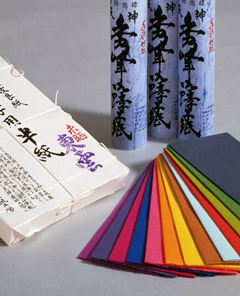OZU Washi (Papers)

Official documents from the Heian era (794-1185) mention paper produced in nearby Iyo, but facts about the production of washi paper in Ozu first appear in the 18th century. It is said that a monk named Zennoshin came to one of the villages of the Ozu clan and taught the people there how to make paper. What developed into a craft industry flourished under the protection and patronage of the clan.
Today, many people are following in the footsteps of those who first crafted this high-quality handmade paper.
Each sheet of Ozu washi paper is individually crafted by hand, giving it a unique warmth and personality lacking in paper mass-produced using machines. In addition to a wide range of traditional paper, items produced today include colored paper that is torn into small pieces to make chigiri-e pictures.
Feature
Compared with paper mass-produced using machines, each sheet of handmade washi paper has a warmer touch and softer feeling. This paper has many traditional uses, including for shoji screens and calligraphy, but more recently has been used to make chigiri-e art.
How to make
Ozu washi paper is made from a variety of plants, including paper mulberry, edgeworthia, gampi, hemp and straw. The traditional process involves boiling, beating, dissolving and agitating the fibers using the nagashi-zuki technique, before drying to obtain the final product.

